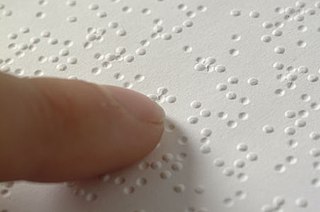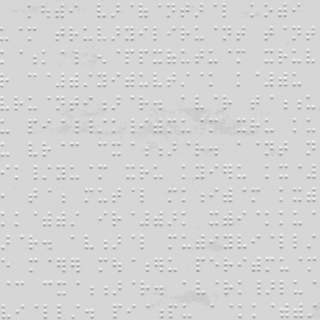
Braille is a tactile writing system used by people who are visually impaired, including people who are blind, deafblind or who have low vision. It can be read either on embossed paper or by using refreshable braille displays that connect to computers and smartphone devices. Braille can be written using a slate and stylus, a braille writer, an electronic braille notetaker or with the use of a computer connected to a braille embosser.
Bharati or Bharathi may refer to:
Hindustani has been written in several different scripts. Most Hindi texts are written in the Devanagari script, which is derived from the Brāhmī script of Ancient India. Most Urdu texts are written in the Urdu alphabet, which comes from the Persian alphabet. Hindustani has been written in both scripts. In recent years, the Latin script has been used in these languages for technological or internationalization reasons. Historically, Kaithi script has also been used.

Russian Braille is the braille alphabet of the Russian language. With suitable extensions, it is used for languages of neighboring countries that are written in Cyrillic in print, such as Ukrainian and Mongolian. It is based on the Latin transliteration of Cyrillic, with additional letters assigned idiosyncratically. In Russian, it is known as Шрифт Брайля.

Bharati braille, or Bharatiya Braille, is a largely unified braille script for writing the languages of India. When India gained independence, eleven braille scripts were in use, in different parts of the country and for different languages. By 1951, a single national standard had been settled on, Bharati braille, which has since been adopted by Sri Lanka, Nepal, and Bangladesh. There are slight differences in the orthographies for Nepali in India and Nepal, and for Tamil in India and Sri Lanka. There are significant differences in Bengali Braille between India and Bangladesh, with several letters differing. Pakistan has not adopted Bharati braille, so the Urdu Braille of Pakistan is an entirely different alphabet than the Urdu Braille of India, with their commonalities largely due to their common inheritance from English or International Braille. Sinhala Braille largely conforms to other Bharati, but differs significantly toward the end of the alphabet, and is covered in its own article.

French Braille is the original braille alphabet, and the basis of all others. The alphabetic order of French has become the basis of the international braille convention, used by most braille alphabets around the world. However, only the 25 basic letters of the French alphabet plus w have become internationalized; the additional letters are largely restricted to French Braille and the alphabets of some neighboring European countries.
Scandinavian Braille is a braille alphabet used, with differences in orthography and punctuation, for the languages of the mainland Nordic countries: Danish, Norwegian, Swedish, and Finnish. In a generally reduced form it is used for Greenlandic.

Tamil Braille is the smallest of the Bharati braille alphabets.
According to UNESCO (2013), there are different braille alphabets for Urdu in India and in Pakistan. The Indian alphabet is based on national Bharati Braille, while the Pakistani alphabet is based on Persian Braille.
Punjabi Braille is the braille alphabet used in India for Punjabi. It is one of the Bharati braille alphabets, and largely conforms to the letter values of the other Bharati alphabets.
Gujarati Braille is one of the Bharati braille alphabets, and it largely conforms to the letter values of the other Bharati alphabets.
Bengali Braille is used for the Bengali and Assamese languages. According to UNESCO (2013), there are slight different braille conventions for Bengali language in Bangladesh and India, this article compares Bengali Braille in the two countries.
Odia Braille is one of the Bharati braille alphabets. Apart from using Hindi æ for Odia ẏ, it conforms to the letter values of the other Bharati alphabets.
Kannada Braille is one of the Bharati braille alphabets, and it largely conforms to the letter values of the other Bharati alphabets.
Malayalam Braille is one of the Bharati braille alphabets, and it largely conforms to the letter values of the other Bharati alphabets.
Sinhala Braille is one of the many Bharati braille alphabets. While it largely conforms to the letter values of other Bharati alphabets, it diverges in the values of the letters assigned toward the end of those alphabets.
Similar braille conventions are used for three languages of India and Nepal that in print are written in Devanagari script: Hindi, Marathi, and Nepali. These are part of a family of related braille alphabets known as Bharati Braille. There are apparently some differences between the Nepali braille alphabet of India and that of Nepal.
Maltese Braille is the braille alphabet of the Maltese language. It was in the news in 2005 with the publication of the first braille Bible in Maltese.
Ukrainian Braille is the braille alphabet of the Ukrainian language. It is based on Russian Braille, with a few additional letters found in the print Ukrainian alphabet.

Spanish Braille is the braille alphabet of Spanish and Galician. It is very close to French Braille, with the addition of a letter for ñ, slight modification of the accented letters and some differences in punctuation. Further conventions have been unified by the Latin American Blind Union, but differences with Spain remain.




